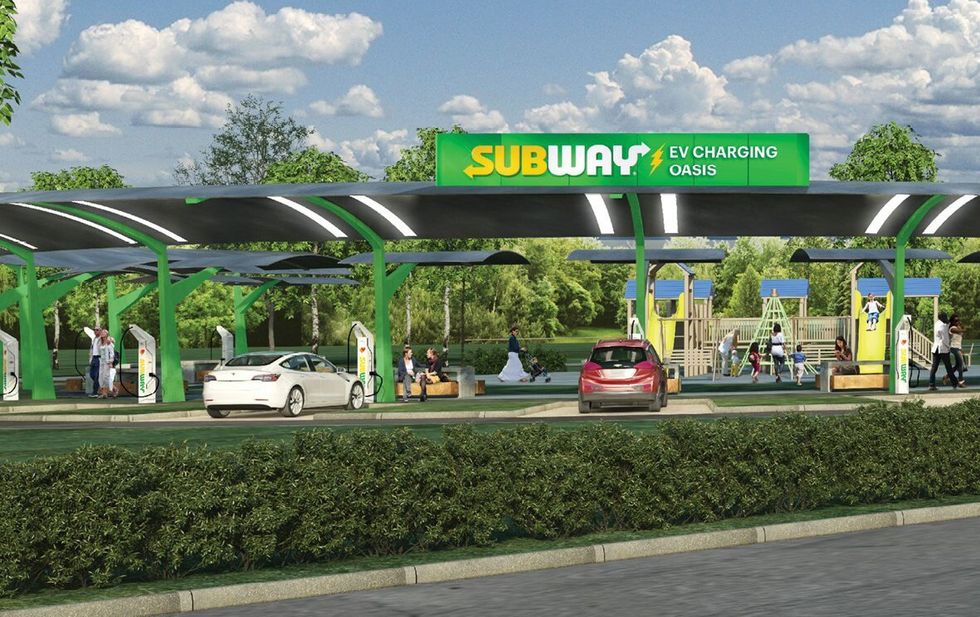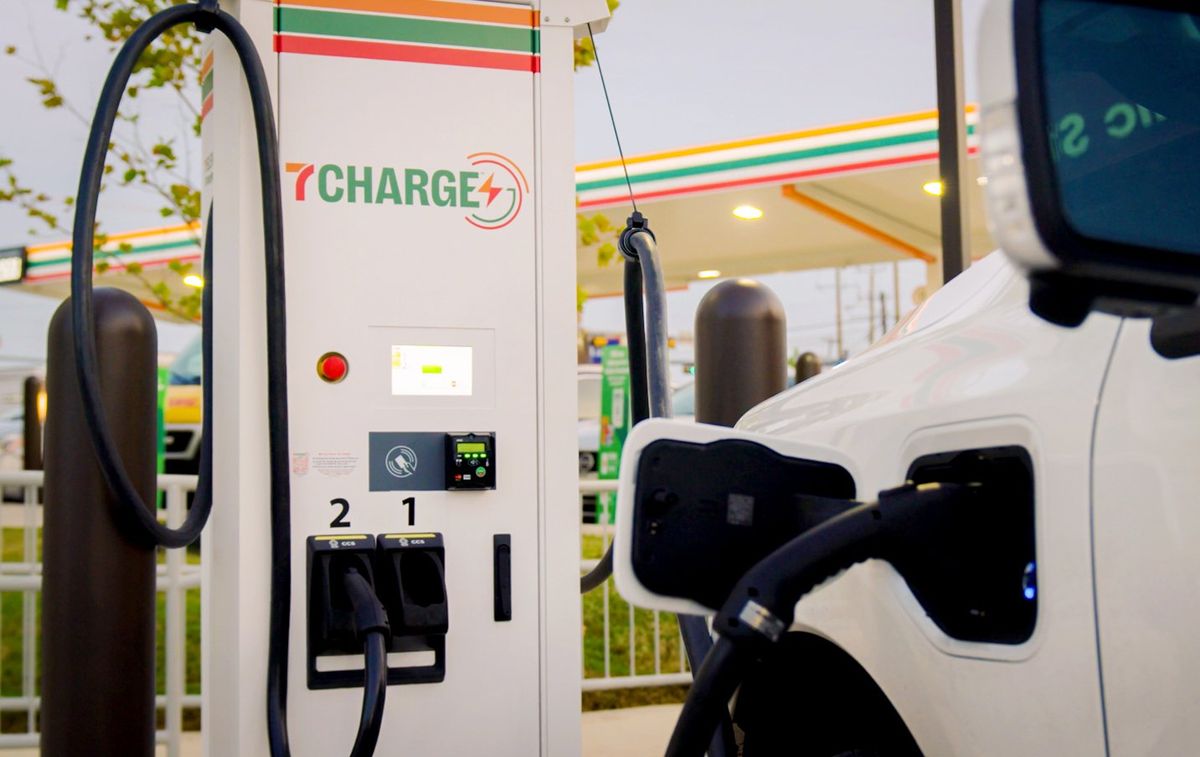It sounds so obvious: Public EV chargers should be located in public, where people tend to gather. The reality has often been otherwise, with too many chargers tucked into desolate parking lots or seemingly random locations. And since even the speediest DC chargers take roughly 30 minutes to juice up an EV, drivers and passengers have time to kill, including enough time for a bite.
To keep cars and passengers full, 7-Eleven and Subway are among the companies planning to serve up EV charging along with their Big Gulps and sandwiches.
7-Eleven envisions its 7Charge network as one of the biggest fast-charging networks among convenience stores in the United States. The company hasn’t cited exact numbers of how many DC chargers it hopes to open, but 7-Eleven operates about 9,400 stores in the United States, and nearly 600 more in Canada. The company currently has more than 30 fast chargers in California, Colorado, Texas, and Florida.
The new chargers aim to welcome owners of any EV, by offering both the CCS (Combined Charging System) connector and the CHAdeMO plug. Tesla owners can already hook into CCS stations by means of an adapter. A 7Charge app will offer a station locator and an easy-payment method through a linked account.
7-Eleven isn’t alone. Subway will partner with Miami-based GenZ EV Solutions to create Subway EV Charging Oasis parks with fast-charging stalls, picnic tables, Wi-Fi, playgrounds, and restrooms. California is determined to require all new vehicles sold to be either EVs or plug-in hybrids by 2035. And a Taco Bell franchisee with more than 300 locations has launched the first of 100 planned California charging stations in San Francisco.
Restaurant and convenience-store operators cite ongoing gaps in public charging, including in rural, urban, and other underserved areas.
“Equitable access to charging is essential to the adoption of EVs, and Subway’s scale will play an important role in democratizing charging infrastructure for millions of Americans,” said Jose Valls, CEO of GenZ EV Solutions.

These new networks look to backstop President Biden’s plan to build 500,000 new EV chargers by 2030, up from around 130,000 today. The moves also underscore Tesla’s foresight in building its own proprietary Supercharger network—the first erected before it sold its first Model S in 2012—specifically to reduce range anxiety and assure potential buyers they could take longer trips in a Tesla. In February, Tesla agreed to open 3,500 of its Supercharger stalls to non-Tesla customers by late 2024, as part of that US $7.5 billion federal bid to expand plug-in infrastructure. Elon Musk’s company also plans to open access to 4,000 of its slower, Level 2 chargers, most in heavily trafficked locations such as hotels and restaurants.
Tesla aside, most major automakers have avoided getting deeply involved in the charging business, akin to car companies also operating gas stations. But with EVs exploding to 5.8 percent of all new-car sales in 2022, several are scrambling to fill a vacuum that’s been left to private charging outfits such as Chargepoint, EVGo, and Electrify America, the latter funded by Volkswagen’s multibillion-dollar “Dieselgate” emissions cheating settlement. And those non-Tesla providers have often been assailed with criticism over balky or broken chargers.
EVs are finally fulfilling the dream of truly practical fill-ups on Interstate runs and vacations, without having to kill hours at every charging stop.
A J.D. Power study of EV owners’ charging experiences found plenty of concerns, including that 20 percent of respondents who visited a public charging station found it broken or out of service.
Aside from balky chargers or stations that dispense juice at lower-than-expected rates, other notorious issues include cords that are too short to easily reach EV charging ports. Scrawny parking spaces and poorly aligned chargers can make it difficult or impossible to access a plug, especially for brawnier electric SUVs and pickups.
Taking matters into its own hands, Ford created “ChargeAngels” to personally visit chargers, report any problems to operators, and get them fixed to ensure that Ford EV owners—the vast majority driving their first-ever EV—don’t get soured on the experience.
General Motors, for its part, is partnering with EVGo on a national network of 2,000 DC fast-charging stalls, located at 500 Pilot and Flying J travel centers. GM is also lining up more than 4,400 dealers to build up to 10 Level 2 charging stations each, at both dealers and key locations, including underserved urban and rural communities. Ninety percent of the U.S. population lives within 10 miles of a GM dealer, according to the company.
VW’s Electrify America is teaming with TravelCenters of America to install about 1,000 DC fast chargers at 200 TA/Petro locations along major highways. Those chargers will include EA’s megapowered 350-kilowatt stalls, currently among the world’s most powerful public units.
Pair those industrial-strength units with EVs that can accept that level of power—meaning cars with architectures of 800 volts or higher, such as the Lucid Air, Porsche Taycan, or the latest Hyundai, Kia, and Genesis models—and the dawdling Level 2 chargers of old can seem nearly obsolete in the public realm. In my recent tests of models including the Hyundai Ioniq and Kia EV6 GT, these stellar examples of the modern EV art charged their batteries to 80 percent full in 20 minutes or less. In other words, EVs are finally fulfilling the dream of truly practical fill-ups on Interstate runs and vacations, without having to kill hours at every charging stop. Such 20-minute stops, of course, are ideally suited to a fast bite on the road, or a needed rest stop on a family vacation.
Brent Gruber, J.D. Power executive director of global automotive, welcomes the rapid expansion of chargers. But Gruber says simply expanding the number of stations isn’t enough.
“Stations need to be added to areas where there are gaps in heavily traveled routes and in high-density areas for people who don’t have access to residential charging, but most importantly, designed with things for users to do while charging—regardless of the use case,” Gruber said. “Then, we need to make sure those stations are reliable.”
Lawrence Ulrich is an award-winning auto writer and former chief auto critic at The New York Times and The Detroit Free Press.



